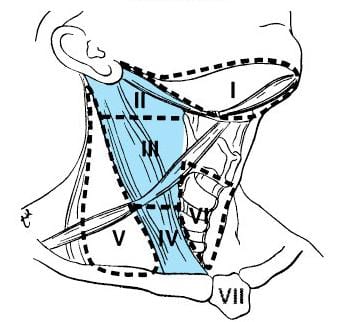Auto text: “Insert Neck Dissection” (many Levels) or “Insert Lymph Node Dissection” (one Level)
Neck Dissections are done for:
- Metastatic carcinoma to lymph nodes (N staging)
- Soft tissue tumor deposits
There are 3 types of Neck Dissections:
- Radical: Includes Levels I through V, sternocleidomastoid muscle, internal jugular vein, and spinal accessory nerve (If you receive a radical neck dissection, please contact an attending for assistance)
- Modified Radical: Includes Levels I through V, while sparing at least one of the anatomic structures in the radical dissection (SCM, IJV, CN-XI) (If you receive a modified radical neck dissection, please contact an attending for assistance)
- Comprehensive: a variant of modified radical that includes Levels I through V while sparing ALL anatomic structures
- Selective: Includes removal of select Levels, with or without anatomic structures such as skin, IJV
Most staging dissections are Selective:
- Submandibular Gland: Level I
- Lateral Neck: Levels II-IV
- Central Neck: Level VI (pre/para-tracheal, pre-cricoid (Delphian), perithyroidal)
- Posterolateral Neck: Levels II-V

Triage
- Most moderate-large neck dissections are best grossed after fixation, but can be done fresh if careful.
- Measure in 3D, noting any sutures that designate Levels.
- Fix in formalin overnight.
Gross – For soft tissue tumor deposits, any Level
- Ink the outer surface.
- For a large, palpable mass: serially section, measure mass in 3D, and submit representative sections (1 per cm including nearest margins).
- Photograph a representative cut section.
- Dissect remaining tissue for lymph nodes as follows.
Gross – Level I including Submandibular Gland
- Many neck dissections include submandibular gland (as part of a larger dissection or on its own). The specimen may be labeled as Level I, as submandibular gland resides in the path of lymphatic drainage in Level I.

Submandibular Gland (tan-yellow lobulated) and Lymph Node Candidates (nodular, brown, at bottom)
- Measure the gland (intact or aggregate, if fragmented).
- Serially section to evaluate for lymph nodes and tumor deposits/lesions.
- Submit all lymph nodes.
- Submit intraparenchymal lesions, if identified.
- If no gross lesions are identified, submit 1-2 representative sections of gland.
- If the neck dissection is being done for metastatic salivary-gland-type tumor and there is no known primary, then then whole gland should be submitted.
Gross – Levels II, III, IV, V, VI, VII
- Unless otherwise designated, assume all LATERAL neck dissections include Levels II, III, and IV.
- Separate the dissection longitudinally into THREE levels (II, III, IV), using sutures as your guidelines.
- Level II = Upper Third
- Level III = Middle Third
- Level IV = Lower Third

- Thoroughly examine each Level for lymph nodes.
- Describe size range of nodes, grossly positive nodes, any obvious soft tissue involvement.
- If you see anything that looks like soft tissue involvement (non-encapsulated, sclerosing, ill-defined), ink the margin adjacent to the lesion and submit sections to demonstrate mass in relation to margin.
- If grossly negative, submit the entire node.
- If grossly positive, submit entirely (if small) or 1 section per cm (if large).
- If only a small amount of fat remains in each Level, submit. Make sure the block summary reflects the number of lymph node candidates you found, designating the Level.




